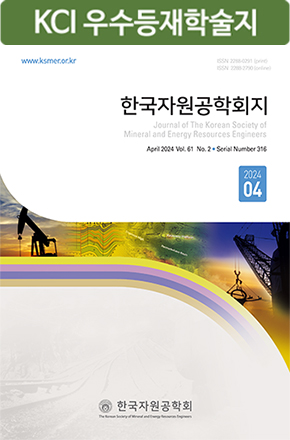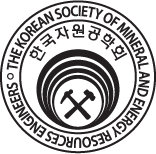Research Paper
Abstract
References
Information
An neutralization-precipitation process for treating an acid mine drainage (AMD) was set up witha process simulator. Flow rate of AMD was 100 m3/d. 150 kg/d of lime was used for neutralizing the AMD.1 kg/d of polymer was used for coagulating the suspended solids. Solid removal rates of 90% and 95% wereassumed for a clarifier and a thicker, respectively. The AMD with a pH of 2.69 contained Fe, Al, Cu and Zn.It was simulated that iron hydroxide could be produced at 32.2 t/yr, aluminum hydroxide at 6.4 t/yr and copperhydroxide at 3.3 t/yr. Simulation result showed that aeration process consumed the largest electricity than otherprocess. It was evaluated that process simulation could play roles in making a better decision for AMD treatmentoptions.
공정분석 시뮬레이터(simulator)를 이용하여 산성광산배수 중화침전공정을 구축하고 시뮬레이션 하였다. 운전 조건으로 광산배수 처리 유량은 100 m3/d 이었고 소석회 및 폴리머 응집제 사용량은 각각 150 kg/d및 1 kg/d 였다. 침전조 및 농축조에서 고형분 제거율을 각각 90%와 95%로 가정하였다. 수질은 pH가 2.69인산성수로서 Fe, Al, Cu, Zn 으로 오염된 광산배수였다. 시뮬레이션 결과 철 수산화물은 30.2 t/yr, 알루미늄 수산화물은 6.4 t/yr 그리고 구리 수산화물은 3.3 t/yr 발생하는 것으로 예상되었다. 폭기 공정에 가장 많은 전력이소요되었다. 시뮬레이션 기법은 산성광산배수 처리 계획 수립시 의사결정에 유용한 도구로 생각되었다.
- Bowell, R.J., 2004, 2015.12.28. “A review of sulfate removal options for mine waters,” http://www.imwa.info/docs/imwa_ 2004/IMWA2004_43_Bowell.pdf.
- DiSandro, D., Schwarz, S. and Alexander, D.J., 2009. Designing Modern Flotation Circuits Using JKFIT and JKSimFloat, in Recent Advances in Mineral Processing Plant Design, SME, pp. 197-201.
- Eby, G.N., 2004, Principles of Environmental Geochemistry, Brooks/Cole, pp. 62-90.
- Go, K.B., Kim, Y.K., Yun, J.W., Lee, B.H., Lim, B.S., Lim, J.R. and Han, M.Y., 1993, Waste water Engineering, Dongwha Technology, pp. 299-397.
- Intelligen, Inc., 2015,10.13., http://www.intelligen.com/.
- Kruse, N.A. and Strosnider, Q.H.J., 2015, “Carbon Dioxide Dynamics and Sequestration in Mine Water and Waste,” Mine Water Environ., Vol. 34 pp. 3-9.
- Manahan, S.E., 1979, Environmental chemistry, Willard grant press, pp. 1-113.
- Means, B., Beam, P.G.R. and Mercer, J., 2015, “Analysis of Hydrated Lime Consumption in Circumneutral Underground Coal Mine Drainage Treatment,” Mine Water Environ, Vol. 34, pp. 10-19.
- Mines, R.O., 2014, Environmental Engineering - Principles and Practices, Wiley Blackwell, pp. 268-276.
- Peters, M.S. and Timmerhaus, K.D., 1991, Plant Design and Economics for Chemical Engineers, McGraw-Hill, NewYork, pp. 1-910.
- Petrides, D., Koulouris, A. and Calandranis, J., 2000, “Evaluation of Water Recycling Options at a Semiconductor Fabrication Plant Using Process Simulation,” the International Water Conference, Pittsburgh, October, 2000.
- Santamarina, V.E., 1997, “Modeling and Optimization of a Municipal Treatment Plant Using EnviroPro Designer,” Environmental progress, Vol. 16, No. 4, pp. 268-273.
- Sengupta, M., 1993, Environmental Impacts of Mining- Monitoring, Restoration and Control, Lewis publishers, London, pp. 121-165.
- Tompson, K., Cadle, S. and Roemer, G., 2015, AMDtreat 5.0+ with PHREQC.
- WVU extension service, 2015.10.13. http://anr.ext.wvu.edu/r/ download/131451.
- Younger, P.L., Banwart, S.A. and Hedin, R.S., 2002, Mine Water-Hydrology, Pollution, Remediation, Kluwer academic publishers, London, pp. 271-286.
- Publisher :The Korean Society of Mineral and Energy Resources Engineers
- Publisher(Ko) :한국자원공학회
- Journal Title :Journal of the Korean Society of Mineral and Energy Resources Engineers
- Journal Title(Ko) :한국자원공학회지
- Volume : 53
- No :1
- Pages :1-9
- DOI :https://doi.org/10.12972/ksmer.2016.53.1.001



 Journal of the Korean Society of Mineral and Energy Resources Engineers
Journal of the Korean Society of Mineral and Energy Resources Engineers








